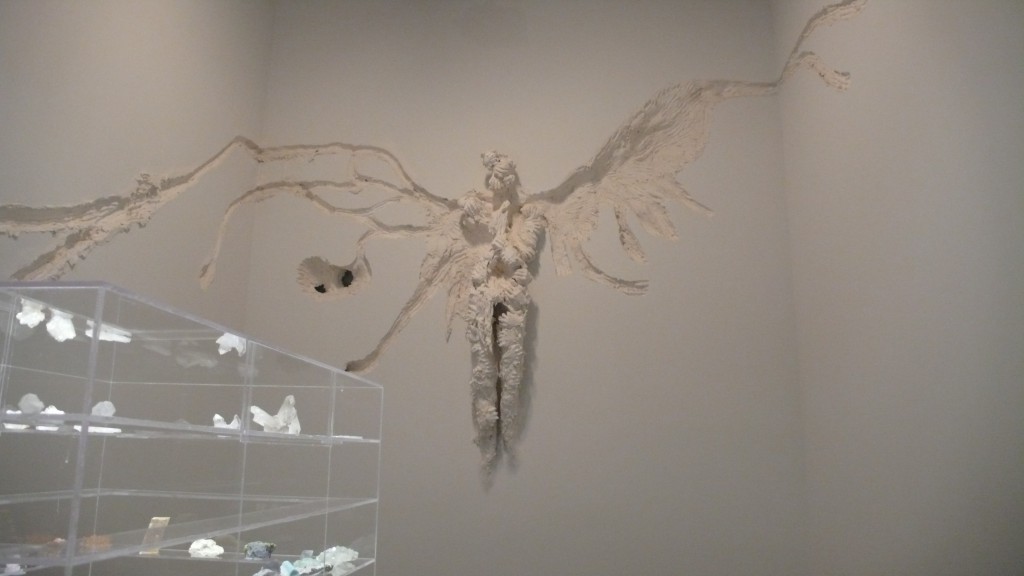
David Altmejd’s two large Plexiglas works fills up the main room at Andrea Rosen Gallery. The works are large, approximately 2 x 4 square meters each and on their low pedestals they shimmer like big aquariums in the dim lit space. In the exhibition there is also wall pieces made of plaster incorporated in the gallery’s walls, freestanding sculptures and other Plexiglas works in the gallery’s inner room and entrance.
The two Plexiglas works titled The Vessel and The Swarm are beautiful and ethereal in their transparent appearance. They are both filled with intricate constructions of Plexiglas levels and walls within the big cube that defines the outline of the works. In, between and through the glace pieces run bits of thin sewing thread. Most of them are white; creating architectural lines that connect the glace pieces with each other. Some of the threads are in the colors of rainbow— from yellow to green or yellow to red— and put together they pierced through the Plexiglas pieces to create different kinds of forms. The colorful thread makes me think of highly stylized flowers or electrical wires. There are also small objects of white plaster incorporated in both constructions; some of them look like lumps and an assortment of human body parts. They are all integrated to large aquarium-like box, like a diorama people can walk around and see in detail.
In the The Vessel there is a Plexiglas level covered with plaster noses in bright colors displayed like jewelry in a store window. But the overall shape of levels, plaster sculptures and thread seems to be mimicking the form of one or several swans. It makes the Plexiglas box more of a museum box, showing us an extraordinary creature, or parts of a specie. There is also a lot of empty space in the box which gives it a lot of light and delicacy. Still, observing the overall appearance of this piece requires time, all the details together in this large scale demands the viewer to look slowly and thoroughly.

In the bottom of the Plexiglas part of the sculpture there are white plaster hands which seem to have dug out pieces of the pedestal. The base becomes a part of the work and with the podium incorporated it makes the whole piece relate more to the floor and the space it sits. It seems like the artist wants to make a smooth transition to the wall pieces that repeat the depiction of the human hands, body and the negative space of a human body. But the transition is a little awkward, the plaster sculpture is not as delicately handled, it is actually quite the opposite. The material is lumpy and grotesque, like a child playing with clay.
The Swarm is the other big Plexiglas piece that combines sculptures of ants and ears in a maze of levels and thread. It is a little more lively, with more colored thread but does not have the same overall shape within the box like The Vessel. The Swarm becomes more of a laboratory where we can see ears and ants, in a labyrinth of threads, trying to escape or breaking in to the glace box. It is exiting because both The Vessel and The Swarm seem to be parts of a bigger narrative that gives the viewer room for imagination.

In the inner room the piece Architect 2 is installed. A larger than life body seems to be dug out from the wall with big angel wings. At the end of the narrow space the angel-like figure is centered similarly to how Jesus figures in churches are placed. This is one of the several white plaster sculpture that is in the exhibition. It is also made in the lumpy and awkward style. The ethereal hint in the Plexiglas box becomes much more concrete in the sculptures. In front of the angel-wall piece is a Plexiglas box containing stones and minerals. The minerals in the glass box, together with the angel like shapes, appropriate a ”New Age” language. This work seems to be more kitsch oriented than the other Plexiglas boxes suggest. The plaster bodies and the negative space created by the body parts that are fixed in the gallery walls become much more literal and overstated then the Plexiglas pieces.
Altmejd’s older work is a lot of freestanding sculptors in a kitsch aesthetic with polyester hair, heavy painted flesh surfaces and deconstructed bodies. He also has a body of perfectly constructed Plexiglas work. The plaster sculptures in Andrea Rosen Gallery have a visual connection to Paul Thek’s work; a bizarre, disgusting and intriguing language, fresh in my mind from the Whitney Museum exhibition. For Thek, that language was more about the artist himself and his relation to his body. In Altmejd’s work the language seems more calculated. The freestanding sculptures are not made in the same aesthetic language as the boxes; there is a disconnect between the works but maybe an intended one. When the Plexiglas constructions take on a clean perfected style with a lot of beautiful details the contrast between the heavy molded sculptures are too big to feel connected. The gallery is not an environment that helps that relationship either, these works do not seem to exist in the same world. If the works were installed in a different environment it would be easier to see them as an installation, in relation to each other but still disconnected.
Lämna ett svar